|
December 31, 1997
NEWS
MATCH REPORTS
STAT SHEET
OTHER SPORTS
SLIDE SHOW
PEOPLE
DEAR REDIFF
|
The year in Indian cricket
Prem Panicker
A friend, aware that I would be writing a year-end review of the Indian cricket scene, sends me a one line e-mail. It reads: "Don't write the cricket piece. You will be too bitter."
Bitter? I don't know. True, I am more fan than commentator -- and that, as I have been finding out, is a rather difficult walk on the highwire, balanced precariously between objectivity and a more "patriotic" admiration.
This kind of dichotomy has, in the past, caused me some heartburn. Till I finally figured out that the only way to play it is to call it the way I see it. And that is pretty much what I propose to do in this piece.
Let's start with a review of the team's performance -- which can be summed up, frankly, in one word. Awful. Not one win in 12 Tests. Just 10 wins in over 35 ODIs. Surely, a team that boasts three batsmen who have crossed the 1000 mark in ODIs this year (not to mention a fourth, Rahul Dravid, who was just 49 short of that figure when the selectors decided he couldn't make the cut), a team that has bowlers of the calibre of Javagal Srinath and Venkatesh Prasad, backed by a rejuvenated Rajesh Chauhan and the promising young Debashish Mohanty, a team wherein at least 5 players would easily walk into any international side today, can't have performed that badly?
The truth is, it did. Taken in terms of pure results, 1997 must surely be the most forgettable year in contemporary cricket history.
Step back and judge by performance, rather than result, and you realise that the year has had its quota of both -- the sublime, and the supremely ridiculous.
The first week of January, for instance, provided perhaps one of the most glorious examples of batsmanship in living memory. The venue was Cape Town, the opponents a South Africa boasting Donald, Pollock, Klusener, McMillan and Adams in the bowling lineup. At lunch, India were 58/5.
It began with Donald bowling an express yorker length delivery and finding it crash into the boundary behind him before he had completed his follow through. That was Tendulkar. Then Azharuddin took over -- and 11 of the first 14 deliveries he faced crashed into the fence, while the bemused South African quicks were reduced to fetch-and-carry merchants.
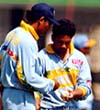 You don't bat with such insouciance in the nets. Far less do you do so when your side is 58/5 faced with a first innings total of 529. But for two hours, between lunch and tea, Sachin Tendulkar and Mohammad Azharuddin elevated the art of batsmanship to a divine plane.
You don't bat with such insouciance in the nets. Far less do you do so when your side is 58/5 faced with a first innings total of 529. But for two hours, between lunch and tea, Sachin Tendulkar and Mohammad Azharuddin elevated the art of batsmanship to a divine plane.
India went on to lose by an immense margin of 282 runs. But after the disaster of Durban, the Tendulkar-Azharuddin blitz indicated that perhaps the myth-merchants were wrong when they talked of Indian batsmen's inability to play pace on fast wickets. And when the side then went on to all but pull off a win in the final Test -- where they were thwarted by a combination of rain and some rather clever work from the groundstaff -- and then, in the final of the SBI ODI series, reduced even the mighty Donald to slavering fury with a brilliant run chase that ended heartstoppingly close to a seemingly improbable target, it appeared that the side was finally beginning to find its feet and realise its full potential.
Not! For if January brought much that was sublime, those memories were quickly erased by the tour of the West Indies that followed. If you look at the scoreboard, you realise that the side consistently outpeformed the Windies, with both bat and ball. But the final scoreboard shows Windies the winners, 1-0 -- thanks to a display of batting as incredibly inept as the earlier demonstration in Cape Town had been sublime.
India chased 120 to win on the last day. We all remember, too clearly, what happened next. True, the wicket was a beast (after all, the Windies themselves had been scuttled out for 140 the day before). True, the Windies bowlers on a helpful track can be devastating. True, seemingly small second innings totals can provide unexpected twists (ask Pakistan, versus South Africa, of more recent vintage). It was not, therefore, the defeat that rankled, so much as the fact that the side went down without the semblance of a fight.
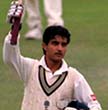 Similarly, it is easy to rank Toronto, and a 4-1 scoreline against Pakistan, as the highest point of the team's cricketing cycle. True, the Pakistan side was not at full strength in the bowling department. But then, neither was India -- and both sides boasted their best batting lineups, so it was pretty even-steven, personnel-wise. Yet, to my mind, Toronto was important merely for the emergency of Saurav Ganguly as a match-winning all rounder, and the unearthing of potential in the likes of Debashish Mohanty and Harvinder Singh.
Similarly, it is easy to rank Toronto, and a 4-1 scoreline against Pakistan, as the highest point of the team's cricketing cycle. True, the Pakistan side was not at full strength in the bowling department. But then, neither was India -- and both sides boasted their best batting lineups, so it was pretty even-steven, personnel-wise. Yet, to my mind, Toronto was important merely for the emergency of Saurav Ganguly as a match-winning all rounder, and the unearthing of potential in the likes of Debashish Mohanty and Harvinder Singh.
The real high point was the win in Karachi -- a tough ask, India's wonted tendency to panic in the chase, an opponent that, Toronto notwithstanding, has always brought out the worst in Indian cricket... and yet the side demonstrated guts and grit in a fighting win that, yet again, had the fans asking themselves hey, how come these guys don't play this way more often?
On a slightly more trivial note, this was the year the rain gods decided to take sides. Result? A narrow escape for South Africa in the third Test. The West Indies off the hook more than once in the Caribbean. (Pakistan, in the Asia Cup, floundering at 35/5 before the game is abandoned -- but that was an ODI). Sri Lanka, in two of three Tests, saved purely by rain and light. In other words, at least four clear results that should have gone in favour of India, but for rain.
If only the "if-onlys" could be entered in the record books....
It was a year, too, of individual gains. And personal loss.
The year when, finally, the myth that India's batting began and ended with Sachin Tendulkar was shattered. The Indian skipper ended up with a 1000-plus in Tests, and another 1000-plus in ODIs -- the only player in his side to pull off the double -- and yet, time and again, the other batsmen weathered his early loss and went on to perform in a way that had not been seen in previous years. Tendulkar, thus, moved from being the be all and end all of Indian cricket to being the first among equals -- and that, any way you look at it, is good for a side.
 The year underlined the promise of Rahul Dravid and Saurav Ganguly -- who, these days, go under the collective sobriquet of the Cola Kids. If the former provided Indian batting the steely core of obduracy, the latter provided the sparkle. If the former was the wall, standing in the way of a collapse, then the latter was an al fresco painting full of bold brushstrokes and delicate flourishes. And together, the two epitomised the promise of tomorrow.
The year underlined the promise of Rahul Dravid and Saurav Ganguly -- who, these days, go under the collective sobriquet of the Cola Kids. If the former provided Indian batting the steely core of obduracy, the latter provided the sparkle. If the former was the wall, standing in the way of a collapse, then the latter was an al fresco painting full of bold brushstrokes and delicate flourishes. And together, the two epitomised the promise of tomorrow.
It was also the year of the fall, and phoenix-like re-emergence, of Javagal Srinath from an eight month layoff through injury. The comeback of Rajesh Chauhan into an aggressive, potentially match-winning bowler. And, perhaps sadly, the further decline of Anil Kumble.
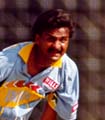 In all, a year of qualitative gains, and quantitative losses.
In all, a year of qualitative gains, and quantitative losses.
Anyway, like the guy said, that is the good news... now we move on to the bad, and the worse...
The year of the committee
They could have saved everyone a lot of trouble by forming one single committee -- and tasking it to devise ways and means of destroying Indian cricket.
Instead, they did it peacemeal. With several committees.
 The Justice Chandrachud committee was the first. If Manoj Prabhakar's allegation of bribery, betting and match-fixing in Indian cricket was a bombshell, then the report of the Justice Chandrachud committee of inquiry, in attempting to sweep said allegation under the carpet, ended up giving it greater legitimacy. Earlier, Prabhakar's allegation was dismissed as the rantings of a rebel without a pause. Following Justice Chandrachud's totally inept attempt at a "probe", however, the fans have begun saying that such an obvious cover-up indicates that Prabhakar is, in fact, right -- if he weren't, runs the argument, why would a judge of Chandrachud's eminence go to such obvious lengths with brush and whitewash?
The Justice Chandrachud committee was the first. If Manoj Prabhakar's allegation of bribery, betting and match-fixing in Indian cricket was a bombshell, then the report of the Justice Chandrachud committee of inquiry, in attempting to sweep said allegation under the carpet, ended up giving it greater legitimacy. Earlier, Prabhakar's allegation was dismissed as the rantings of a rebel without a pause. Following Justice Chandrachud's totally inept attempt at a "probe", however, the fans have begun saying that such an obvious cover-up indicates that Prabhakar is, in fact, right -- if he weren't, runs the argument, why would a judge of Chandrachud's eminence go to such obvious lengths with brush and whitewash?
The BCCI, meanwhile, decided to reward sycophancy with plum postings on various "honorary" committees. Thus, we had a technical committee under no less than Sunil Gavaskar -- which did not meet even once throughout the year, because "there was nothing to discuss".
Funny. Early in the year, the ICC's own technical committee considered, and okayed, a proposal by the cricket boards of Australia and South Africa for permitting the use of lights in Test matches, in order to ensure that rain and bad light did not prevent matches from going the distance.
The first series India participated in after that ruling was the recent three-Test Pepsi Series against Sri Lanka. The second Test was totally washed out -- fair enough. The first Test at Mohali saw rain and bad light rob 90 overs worth of play -- and India remained content with a draw, where it could have forced a win. The third Test at Bombay saw India poised to win -- when, yet again, light intervened.
In both venues, majestic light pylons, bearing their loads of bulbs, brooded over the depressing scenario. Why were they not turned on? Because they were not part of the playing conditions agreed upon by the two teams. Why were they not part of the playing conditions? In good part, because the technical committee did not see the need to assess the ICC ruling and indicate, to the BCCI, that it should be practised in India.
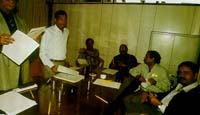 The BCCI has a tour committee, for finalising fixtures and programmes. Judging by the evidence, said committee appears to be comprised of demented travel agents. Remember the first part of the year? Tests in South Africa. Then an ODI triangular. Then, for no reason anyone could see, a trip to Zimbabwe. And worse, a further trip to Bermuda of all places -- all this, after the team had gone through a tough six Tests, three at home and three away, against one of the most demanding opponents in the game. And immediately before a strenous tour of the Caribbean.
The BCCI has a tour committee, for finalising fixtures and programmes. Judging by the evidence, said committee appears to be comprised of demented travel agents. Remember the first part of the year? Tests in South Africa. Then an ODI triangular. Then, for no reason anyone could see, a trip to Zimbabwe. And worse, a further trip to Bermuda of all places -- all this, after the team had gone through a tough six Tests, three at home and three away, against one of the most demanding opponents in the game. And immediately before a strenous tour of the Caribbean.
Or consider the end of the year -- India plays Sri Lanka in three Tests spanning November 19-December 7 (15 playing days in 20, plus travel time to three different venues). On the fourth day after the end of the third Test, India is playing the first game of a one-day tournament in Sharjah. The finals of which are on the 19th (it is a different matter that India did not make it to the final -- when you draw up an itinerary, you don't know that). And on the 22nd -- that is, on the third day, and keep in mind here that the Sharjah tournament being a day-night affair, the team would only have been able to fly back the next day -- India is taking on the world champions of one day cricket in the first of three games.
'Nuff said?
The BCCI has a pitches committee. To "improve the condition of wickets in India and bring them up to international standards". Two months after the formation of said committee, Kapil Dev returns his "honorarium" of Rs 30,000, arguing that the committee never meets or does any work. And right at the end of the year, India creates history when, for the first time in the international arena, a game is called off because the pitch prepared for it is deemed too dangerous.
So what do we do? Simple -- appoint a pitches committee to probe the pitch. Which, in case it needs rubbing in, the earlier pitch committee was supposed to have brought up to international standard anyway.
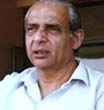 The BCCI has a finance committee. Headed by a certain Purushottam Rungta who, just coincidentally, happens to be the guy responsible for ensuring Raj Singh Dungarpur's election as Board president and whose brother Kishen -- again, pure coincidence folks, any resemblance to a quid-pro-quo situation is purely accidental -- is a member in good standing of the national selection committee. Said finance committee has no trouble finding funds for a general body meeting of the board, in Calcutta, where the only decisions taken are to confirm the appointment of Ratnakar Shetty as team manager in Sri Lanka (at which point, the tour is just ending anyway). No problem finding funds to ensure that the selectors, during the recent three-Test tour by Sri Lanka, are flown from Mumbai, where they pick the side for the first Test, to Mohali, where they stay in five-star luxury before retaining the same team for the second Test at Guwahati, where they are flown and installed in five-star comfort before.... you get the idea. But when it comes to finding funds to appoint a physical fitness trainer for the side -- uh huh, sorry, no money, it doesn't grow on trees, you know!
The BCCI has a finance committee. Headed by a certain Purushottam Rungta who, just coincidentally, happens to be the guy responsible for ensuring Raj Singh Dungarpur's election as Board president and whose brother Kishen -- again, pure coincidence folks, any resemblance to a quid-pro-quo situation is purely accidental -- is a member in good standing of the national selection committee. Said finance committee has no trouble finding funds for a general body meeting of the board, in Calcutta, where the only decisions taken are to confirm the appointment of Ratnakar Shetty as team manager in Sri Lanka (at which point, the tour is just ending anyway). No problem finding funds to ensure that the selectors, during the recent three-Test tour by Sri Lanka, are flown from Mumbai, where they pick the side for the first Test, to Mohali, where they stay in five-star luxury before retaining the same team for the second Test at Guwahati, where they are flown and installed in five-star comfort before.... you get the idea. But when it comes to finding funds to appoint a physical fitness trainer for the side -- uh huh, sorry, no money, it doesn't grow on trees, you know!
Result -- the most overworked team in international cricket remains the most unfit team in ditto.
And then -- I was saving the best for the last, here -- we have a national selection committee. Their individual acts of omission and commission have been too well chronicled on this site to merit reiteration.
However, in broad strokes, the picture that emerges is of a group of individuals so arrogant in their security (a security, it needs mentioning, that stems from the fact that they supported the winning faction in the Board elections this year) that they have behaved, throughout, like a bunch of pocket Hitlers.
Never mind the absolute lack of reason in their various selections. Look, instead, at their overall behaviour. By leaking word to the media that a section of them is in favour of deposing the present captain and re-installing the former one, they create dissension within the side, and set up an alternate power centre (and what collection of individuals can function with two masters?).
In the absolute arrogance of absolute power, they, further, systematically take over the duties that are traditionally those of captain and coach. Thus, when the Board President's XI plays Sri Lanka in the warm up game, they insist that captain Venkatesh Prasad, on winning the toss, should bowl first -- never mind that the pitch is deader than 1996 -- so they can "see him bowl" (never mind, again, that they travelled luxuriously to three different venues to watch that same bowler perform in Ranji Trophy competition). Then, when Prasad elects to bat first, they punish him by insisting that he should not be part of the playing eleven.
Then they take it a step further, by descending to downright blackmail -- you want to be captain? You have to bat at number 4!
Then they shrug off the reins in toto -- and decide to "experiment". With youth, in the form of the 24 year old V V S Laxman, at the expense of Rahul Dravid, also 24. (I wonder if they are even aware of the fact that besides an aggregate of 951 runs this calendar year -- in which, mind, he did not figure in some ODIs, Dravid also has a better strike rate than Mohammad Azharuddin in all ODI competitions except those in Sri Lanka and Toronto?). With the opening slot, where after picking Sidhu as opener, they decide that the explosive middle order batsman, Ajay Jadeja, should be defused by making him open. And so on, and so forth...
And thus, a step at a time, they take into their hands ever more power -- the power to overrule captain and coach when picking teams, the power to decide playing elevens, the power to decide the batting order... all the power in the world, and not one jot of accountability.
So we will merely sum up -- by pointing out that we have, too, a situation where it has been conclusively proved that a group of five men, if they really spit on their hands and get right down to it, can destroy, with effortless ease, the hopes and aspirations not only of a national side, but also of the 100s of millions of fans who follow the game with a passion.
You know what is even worse? The fact that this selection committee's term continues till September 1988 -- so what you see at the end of the tunnel, folks, is not light, but an even bigger, blacker tunnel.
The BCCI
 When I sat down for a similar exercise this day last year, I talked of how Dungarpur, then just two months into his tenure as Board president, had promised to begin work, pronto, on four things of crucial importance to Indian cricket: to wit, the appointment of a qualified physical fitness trainer for the Indian team, the re-laying of pitches at key centres to bring them on par with international standards, the appointment of a highly qualified coach for the side, the founding of a national cricket academy to develop and train promising youngsters.
When I sat down for a similar exercise this day last year, I talked of how Dungarpur, then just two months into his tenure as Board president, had promised to begin work, pronto, on four things of crucial importance to Indian cricket: to wit, the appointment of a qualified physical fitness trainer for the Indian team, the re-laying of pitches at key centres to bring them on par with international standards, the appointment of a highly qualified coach for the side, the founding of a national cricket academy to develop and train promising youngsters.
A year later, every single promise remains unfulfilled. Except, of course, that bit about the foreign coach. Dungarpur and Lele recently did appoint a "consultant coach", Bobby Simpson to wit, to help the team get its act together, the appointment to last till the end of the 1999 World Cup.
The only catch here is that said Simpson knows nothing whatsoever about this! We spoke to Dungarpur, when Simpson's denial hit the wires. The short -- very short -- conversation is fraught with interest, and runs thusly:
Mr Dungarpur, you had announced that Mr Simpson had been appointed coach of the Indian team?
"That is right. Consultant coach, actually -- he will be sort of coach for the Indian coach, and his contract will run till the end of India's World Cup campaign."
But Mr Simpson denies the appointment...?
"Well, we actually decided only last evening, and haven't had a chance to discuss it with Simpson yet. But he is a good friend of mine and will not say no!"
End of conversation -- mainly because we were too shocked to continue. I mean, you ever hear of an appointment being made, at any level, without even consulting the appointee?
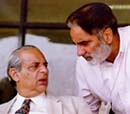 But Dungarpur's place in cricket history is assured for an entirely different reason -- for it was he who presided over the most bitter, most openly corrupt, most virulent election in the BCCI's history. The first general body meeting adjourns in discord without conducting the elections. The second witnesses a no-holds-barred battle for power between friends turned rivals Dalmiya and Bindra, wherein money, muscle and political patronage are all employed by both factions.
But Dungarpur's place in cricket history is assured for an entirely different reason -- for it was he who presided over the most bitter, most openly corrupt, most virulent election in the BCCI's history. The first general body meeting adjourns in discord without conducting the elections. The second witnesses a no-holds-barred battle for power between friends turned rivals Dalmiya and Bindra, wherein money, muscle and political patronage are all employed by both factions.
Ever since, Indian cricket has been paying the price. Associations that supported the Dalmiya-Dungarpur faction have been paid off, vide the retention of the selection committee, the granting of international fixtures to clearly unfit venues (Indore being only one example), the appointment of "friendly" power brokers to important committees, and so on...
And given the way things are shaping, one gets the sneaky feeling that the real bill will only be presented this coming year.
Jaywant Lele
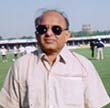 A Shakespearian character said it best: "I laugh, that I may not weep!"
A Shakespearian character said it best: "I laugh, that I may not weep!"
For the 365 days of 1997, Board secretary Jaywant Lele has stunned the nation with the felicity with which he navigates with foot firmly in mouth.
His various gaffes are already the stuff of contemporary legend -- we won't reiterate them here. But will, rather, content ourselves with a little reminder to the gent.
At the start of the year, he had promised a physical trainer for a patently unfit side. In May, he told me in Bangalore that it was being considered on a high priority basis. In late October, he said that he was in touch with Bobby Simpson and that the latter had recommended some names, and that a final decision would be taken once the former Australian captain arrived in India as ICC match referee for the India-Sri Lanka series. On December 8, a day after the Test series ended and Simpson returned home, Lele said that a trainer had been finalised, negotiations were on, and an appointment would be made, and announced, in 15 days time.
It is now 23 days, and counting.
Why do I get the feeling that this time next year, I will still be counting?
The year of the myth
Above all else, this has been the year when the media -- or rather, sections thereof -- carried irresponsibility to extremes. And I am not referring to the Manoj Prabhakar imbroglio here.
 Consider these examples -- a national newsmagazine blithely front-pages a "story" that the national selectors, plus unnamed officials of the BCCI, have "decided" to sack Sachin Tendulkar as captain. The story appears shortly before the India-Sri Lanka series -- and said magazine seemingly does not care for the immense harm such tales can do to team morale. A captain can succeed when, and only when, he has the confidence of his team. How much confidence was the average Indian player supposed to invest in his captain after that little number hit the stands? Meanwhile, a section of the selectors further push the good work along, by getting their tame hatchet men in the media to frontpage a series of stories about Tendulkar's alarming lack of form -- attributing it to the pressures of captaincy -- and the urgent need for his ouster, in order to "save his batting". This, at a time when Tendulkar has, as pointed out, 1000+ in both forms of the game -- if that is lack of form, then what about the other players, who do not even have as much? This, further, when Tendulkar is averaging 64+ -- higher, not lower, than his lifetime average.
Consider these examples -- a national newsmagazine blithely front-pages a "story" that the national selectors, plus unnamed officials of the BCCI, have "decided" to sack Sachin Tendulkar as captain. The story appears shortly before the India-Sri Lanka series -- and said magazine seemingly does not care for the immense harm such tales can do to team morale. A captain can succeed when, and only when, he has the confidence of his team. How much confidence was the average Indian player supposed to invest in his captain after that little number hit the stands? Meanwhile, a section of the selectors further push the good work along, by getting their tame hatchet men in the media to frontpage a series of stories about Tendulkar's alarming lack of form -- attributing it to the pressures of captaincy -- and the urgent need for his ouster, in order to "save his batting". This, at a time when Tendulkar has, as pointed out, 1000+ in both forms of the game -- if that is lack of form, then what about the other players, who do not even have as much? This, further, when Tendulkar is averaging 64+ -- higher, not lower, than his lifetime average.
What did the story do? It bred, in the minds of a section at least of fans, the feeling that it was true. Even as it added to the immense pressure the Indian captain is already under. The result? A 24 year old boy of proven talent today has the careworn visage, the stooped shoulders and bowed head, of a 42-year-old.
Meanwhile, another section of the media does an "analysis" piece on Saurav Ganguly -- and comes to the conclusion that Sachin Tendulkar does not give him bowling because Sachin represents (or did, at the time) Pepsi, while Ganguly endorses Coke! (Never mind that when Tendulkar used Ganguly as his main weapon in Toronto, said section of the media conveniently ignored the development).
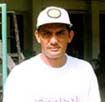 And to round off the year, yet another section floats the story that the real reason for Rahul Dravid's ouster from the one day squad is not selectorial machinations but, you guessed it, Sachin Tendulkar. You see, Sachin used to endorse Pepsi. Now, it is Rahul Dravid who puts the fizz in that cola's campaign. So a jealous Sachin Tendulkar....
And to round off the year, yet another section floats the story that the real reason for Rahul Dravid's ouster from the one day squad is not selectorial machinations but, you guessed it, Sachin Tendulkar. You see, Sachin used to endorse Pepsi. Now, it is Rahul Dravid who puts the fizz in that cola's campaign. So a jealous Sachin Tendulkar....
Judge Learned Hand of the United States Supreme Court said it best: "The right to free speech does not mean the right to shout 'FIRE!' in a crowded theatre!"
One could go on, and on. But at the end of it all, the conclusion is inescapable -- 1997 is, for Indian cricket, an eminently forgettable year. And the sooner such amnesia strikes, the better...
Prem Panicker
|